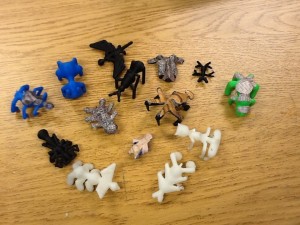Almost a million different species of insects have been identified and catalogued living in almost every imaginable habitat on the planet. Clark Barnett’s 4th grade class just discovered a few more of them living in their Afinia 3D printer.
So what would an insect living in a 4th grade classroom look like? Would it have wings? Would it be a scavenger? Would it be a predator? These are the questions that California educator Clark Barnett asks his class for his 3D Printed Entomology lesson. Once his students have discovered their new insect he even helps them design and 3D print them.

“As a teacher, I always thought that I taught like everyone else, which I have found is not the case. I’ve learned that at the core of teaching is planning how to present information. I’ve moved to a more student-centered teaching pedagogy, which puts more of the learning in the kids’ hands. It’s definitely different than what my colleagues do. We all plan together; I just use technology that they are not familiar with, yet. I’m teaching them, though.”

Barnett explains why his 3D printed insect lesson works: “Entomology requires students to know a lot about insects and their parts. Instead of having them memorize this I used experiential education. When they are designing an insect the kids want to know what the parts are called. In my opinion, this is a much better way for them to learn, as opposed to rote memorization. I also included in the curriculum links to kid-friendly entomology web sites so that they could study on their own. One student got so excited about that extra knowledge she brought a giant, live, bug into class, which we studied.”
Once his students have written a detailed study of their insects he has them draw a picture and then helps them create a 3D model of it using Autodesk’s 123D Creature. The next step is printing out the insect on his Afinia 3D printer and having them take observation pictures of the insects in their natural habitats. He also had them create stop motion video’s of his insects and uploaded them to YouTube. They’re pretty cute and worth a look just for the creative insect models alone.
Teachers see in us things that no one else has ever seen, and push us to travel paths that we never imagined were options for us. They teach us to tie our shoes, they help us learn to communicate, and how to be communicated with. Teachers shape us in a million little ways that are almost always taken for granted by all of us. They help us transform from children to adults. We need more educators like Clark Barnett, and we need to give him the resources that he needs to educate. After all, he’s trying to 3D print our next generation and he’s doing it one 3D printed bug at a time.
You can read Afinia’s excellent interview with Barnett here, and you can read more about him, his lesson plans and his fourth grade class here.
Source: Afinia



